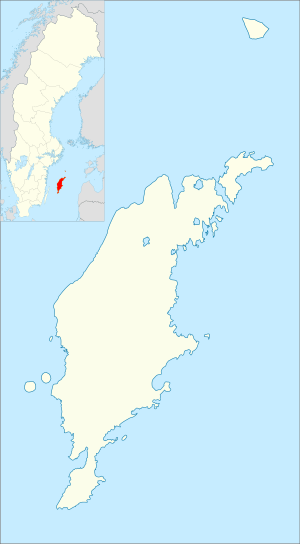Fårösund
Fårösund is a locality situated on the Swedish island of Gotland with 800 inhabitants in 2014.[2] The village can be reached by car from Visby. The island of Fårö can be reached by ferry from Fårösund.[3]
Fårösund | |
|---|---|
 Strandvägen in Fårösund | |
 Fårösund | |
| Coordinates: 57°52′N 19°03′E | |
| Country | Sweden |
| Province | Gotland |
| County | Gotland County |
| Municipality | Gotland Municipality |
| Area | |
| • Total | 2.89 km2 (1.12 sq mi) |
| Population (31 December 2014)[2] | |
| • Total | 800 |
| • Density | 282/km2 (730/sq mi) |
| Time zone | UTC+1 (CET) |
| • Summer (DST) | UTC+2 (CEST) |
Fårösund is the northernmost town in the municipality of Gotland in Gotland County, about 56 km (35 mi) north of Visby. Fårösund is situated on the seafront overlooking the island of Fårö and is visited by tourists during the summer, but it is usually a quiet community in the autumn, winter and spring. Until the mid-1900s it was a small quiet resort as well as a ferry terminal for ferries to Fårö.[3] As of February 2017 the Swedish Government is attempting to buy back the former naval port and related facilities, in the face of opposition from private interests including a Russian oligarch, as part of the emergency remilitarization of Gotland in the second half of the 2010s.
Fårösund is also the name of the strait between Gotland's "mainland" and Fårö.[4]
History
During the Crimean War, the fleet of the alliance opposing the Russian Empire used Fårösund as their Baltic Sea base. An artillery battery for the defence of the southern part of the inlet to Fårösund had been built in 1721, on the south shore opposite the Skarv shallows, and a blockhouse housing two 8 pounder cannons was constructed further out on the Bungenäs. After the Treaty of Nystad in 1721, these fortifications were abandoned. In 1818, Fårösund's importance as a Naval base was once again brought to light. In 1885, when it seemed like there could be a conflict between Russia and the UK, the area around the town was further fortified by placing a line of naval mines around the harbor. This escalation of the defence was made to indicate that Sweden was determined to maintain its neutrality. Therefore, a battery housing of seven 12 cm muzzle-loading guns was hastily built at the south end of the strait. Later, a similar but smaller battery was built at the north end and finally a third, for heavier artillery, southeast of the first battery. In 1900–02, the two first batteries were converted and updated with more modern armament. Since 1905, there was a coastal artillery detachment from Vaxholm Coastal Artillery Regiment (KA 1) stationed in Fårösund where barracks for the unit had been built in 1902–06.[5]
The Gotland Coastal Artillery Regiment (KA 3), established in 1937, started an economic boom in the town including the building of a new shipyard. Prior to the 1950s, the port also served as a submarine base (it remained available as a forward operating location for submarines up until the 1990s). The regiment, however, was dissolved in 2000. As of 2002, the old military regiment area is demilitarized and used by many companies that have started since the regiment was closed.[3] In February 2017 though it was being reported (initially by the daily business newspaper Dagens Industri) that the government, in the form of the Swedish Fortifications Agency, was attempting to buy back the old military facilities including the port despite competing bids from private interests including the controversial Russian billionaire Vladimir Antonov who wished to procure them for their own purposes.[6][7] This was part of ongoing efforts to rebuild Gotland's (and by extension, Sweden's) defences in light of the continuing deterioration in regional stability.
In January 2018 the Swedish Armed Forces have reportedly bought back the base in a deal under negotiation since February 2017. The purchase faced competition from a Russian oligarch who showed interest in the port, but the sale went to the Swedish Fortifications Agency, which paid 20 million Swedish krona for it, after having sold it for 18 million in 2004. The sale requires government approval before 16 April 2018, and the Swedish Armed Forces are to take the base over on 30 April 2018.[8]
See also
References
- "Tätorternas landareal, folkmängd och invånare per km2 2005 och 2010" (in Swedish). Statistics Sweden. 14 December 2011. Archived from the original on 10 January 2012. Retrieved 10 January 2012.
- "Gotland i siffror 2015" [Gotland in numbers 2015]. www.gotland.se. Gotland Municipality. Retrieved 25 May 2016.
- "Bunge socken med Fårösunds samhälle". www.bunge.se. Bunge Socken Society. Retrieved 16 June 2015.
- "Vatteninformationssystem Sverige - Fårösund". www.viss.lansstyrelsen.se. Vattenmyndigheterna & Länsstyrelserna. Retrieved 16 June 2015.
- Westrin, Th., ed. (1908). Nordisk familjebok: konversationslexikon och realencyklopedi. 9 (Ny, rev. och rikt ill. uppl. ed.). Stockholm: Nordisk familjeboks förlag. p. 205.
- Malteson, Evelina (24 February 2017). "Rysk oligark vill köpa ubåtshamn på Gotland". Dina pengar (part of the Expressen newspaper/website) (in Swedish). Sweden/online: Expressen (part of the Bonnier Group. Retrieved 10 March 2017.
- CDRSalamander (8 March 2010). "A Swedish Lesson on BRAC". USNI blog. United States Naval Institute. Retrieved 10 March 2017.
- "Sweden buys back previously sold Gotland submarine base". Naval Today. 19 January 2018. Archived from the original on 20 January 2018. Retrieved 20 January 2018.
External links
- Objects from Fårösund at the Digital Museum by Nordic Museum

